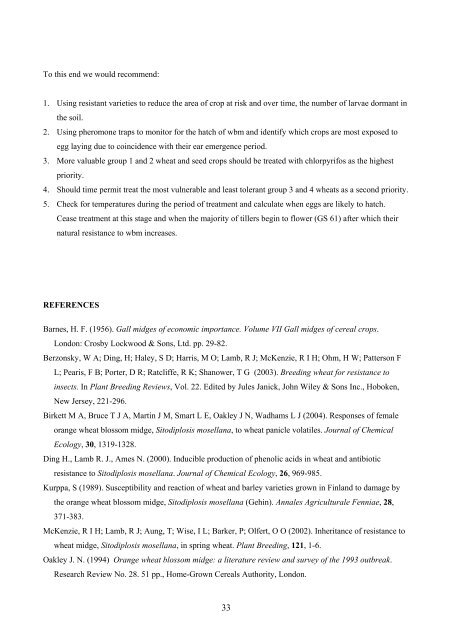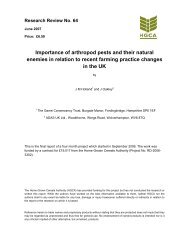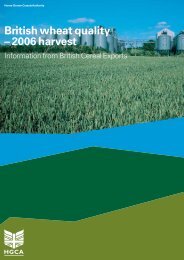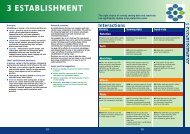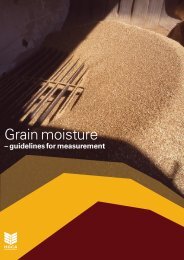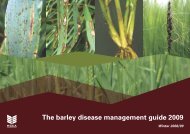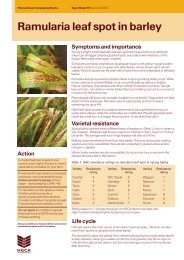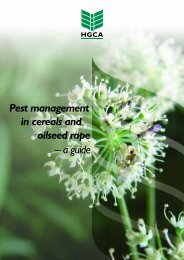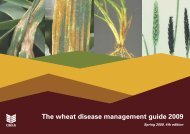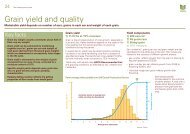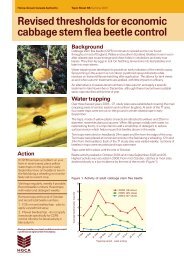Integrated control of wheat blossom midge - HGCA
Integrated control of wheat blossom midge - HGCA
Integrated control of wheat blossom midge - HGCA
Create successful ePaper yourself
Turn your PDF publications into a flip-book with our unique Google optimized e-Paper software.
To this end we would recommend:1. Using resistant varieties to reduce the area <strong>of</strong> crop at risk and over time, the number <strong>of</strong> larvae dormant inthe soil.2. Using pheromone traps to monitor for the hatch <strong>of</strong> wbm and identify which crops are most exposed toegg laying due to coincidence with their ear emergence period.3. More valuable group 1 and 2 <strong>wheat</strong> and seed crops should be treated with chlorpyrifos as the highestpriority.4. Should time permit treat the most vulnerable and least tolerant group 3 and 4 <strong>wheat</strong>s as a second priority.5. Check for temperatures during the period <strong>of</strong> treatment and calculate when eggs are likely to hatch.Cease treatment at this stage and when the majority <strong>of</strong> tillers begin to flower (GS 61) after which theirnatural resistance to wbm increases.REFERENCESBarnes, H. F. (1956). Gall <strong>midge</strong>s <strong>of</strong> economic importance. Volume VII Gall <strong>midge</strong>s <strong>of</strong> cereal crops.London: Crosby Lockwood & Sons, Ltd. pp. 29-82.Berzonsky, W A; Ding, H; Haley, S D; Harris, M O; Lamb, R J; McKenzie, R I H; Ohm, H W; Patterson FL; Pearis, F B; Porter, D R; Ratcliffe, R K; Shanower, T G (2003). Breeding <strong>wheat</strong> for resistance toinsects. In Plant Breeding Reviews, Vol. 22. Edited by Jules Janick, John Wiley & Sons Inc., Hoboken,New Jersey, 221-296.Birkett M A, Bruce T J A, Martin J M, Smart L E, Oakley J N, Wadhams L J (2004). Responses <strong>of</strong> femaleorange <strong>wheat</strong> <strong>blossom</strong> <strong>midge</strong>, Sitodiplosis mosellana, to <strong>wheat</strong> panicle volatiles. Journal <strong>of</strong> ChemicalEcology, 30, 1319-1328.Ding H., Lamb R. J., Ames N. (2000). Inducible production <strong>of</strong> phenolic acids in <strong>wheat</strong> and antibioticresistance to Sitodiplosis mosellana. Journal <strong>of</strong> Chemical Ecology, 26, 969-985.Kurppa, S (1989). Susceptibility and reaction <strong>of</strong> <strong>wheat</strong> and barley varieties grown in Finland to damage bythe orange <strong>wheat</strong> <strong>blossom</strong> <strong>midge</strong>, Sitodiplosis mosellana (Gehin). Annales Agriculturale Fenniae, 28,371-383.McKenzie, R I H; Lamb, R J; Aung, T; Wise, I L; Barker, P; Olfert, O O (2002). Inheritance <strong>of</strong> resistance to<strong>wheat</strong> <strong>midge</strong>, Sitodiplosis mosellana, in spring <strong>wheat</strong>. Plant Breeding, 121, 1-6.Oakley J. N. (1994) Orange <strong>wheat</strong> <strong>blossom</strong> <strong>midge</strong>: a literature review and survey <strong>of</strong> the 1993 outbreak.Research Review No. 28. 51 pp., Home-Grown Cereals Authority, London.33


